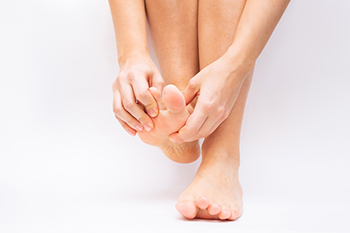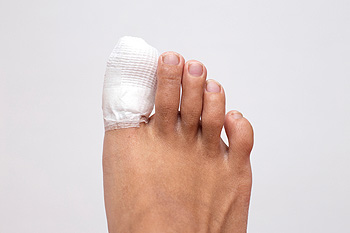Flint Office
1303 S. Linden Rd., Suite D
Flint, MI 48532

Taking care of the feet ought to be an essential component of anyone’s daily or weekly self-care routine. Sometimes, if someone is caring for and pampering their feet, they might notice hairs growing on the toes, especially the big toe. Although this might seem alarming and unsightly, hair on the toes does not indicate anything problematic in many cases. If anything, hair on the toes indicates good blood circulation. If you do not want hair on your toes, you might safely remove the hairs by using a standard shower razor and shaving gel. Importantly, if you feel as though the hair on your toes is more than normal (especially if you have a kind of adrenal or ovarian disorder), you might consider seeking out medical attention. Contact a podiatrist today to learn more about hair on the toes.
Everyday foot care is very important to prevent infection and other foot ailments. If you need your feet checked, contact one of our podiatrists from Community Podiatry Group. Our doctors can provide the care you need to keep you pain-free and on your feet.
Everyday Foot Care
Often, people take care of their bodies, face and hair more so than they do for their feet. But the feet are a very important aspect of our bodies, and one that we should pay more attention to. Without our feet, we would not be able to perform most daily tasks.
It is best to check your feet regularly to make sure there are no new bruises or cuts that you may not have noticed before. For dry feet, moisturizer can easily be a remedy and can be applied as often as necessary to the affected areas. Wearing shoes that fit well can also help you maintain good foot health, as well as making it easier to walk and do daily activities without the stress or pain of ill-fitting shoes, high heels, or even flip flops. Wearing clean socks with closed shoes is important to ensure that sweat and bacteria do not accumulate within the shoe. Clean socks help to prevent Athlete’s foot, fungi problems, bad odors, and can absorb sweat.
If you have any questions please feel free to contact our office located in Flint, MI . We offer the newest diagnostic and treatment technologies for all your foot and ankle needs.

Foot injuries among athletes usually come from overuse. Feet basically dictate the rest of the movements in the lower body. They function to absorb shock and provide a rigid surface to push off from. High stress placed on feet during sports can cause imbalances in muscles that may lead to biomechanical dysfunction of the feet. This in turn can cause pain and interference with an athlete’s mobility. The most common overuse injuries among athletes include turf toe, bunions, and plantar fasciitis. Turf toe happens due to repetitive hyperextension of the big toe. This is seen in athletes who wear shoes that are lightweight and flexible and performing movements that require repeated and forced hyperextension of the big toe. Pain in the big toe is the most common symptom of this condition. Bunions happen to those who over-pronate. Instead of using muscles to support the arch, patients may rely on ligaments and bones to support the foot when walking, and this may cause the arch to collapse. Push off is from the big toe rather than the ball of the foot. The most common symptom is pain at the inside of the big toe. This is worsened by wearing narrow shoes with insufficient room in the toe box. Over time, the big toe moves towards the other toes. Plantar fasciitis happens to athletes who over-pronate and do not have enough strength in their foot muscles. It is associated with running, jumping, and other repetitive movements. It comes from inflammation and micro-tearing of the plantar fascia. Someone with plantar fasciitis has pain with their first steps in the morning, tenderness along the arch and heel of the foot, and tenderness in the plantar fascia. If you are an athlete and experience foot pain, it is wise to consult with a podiatrist who can make a proper diagnosis and provide appropriate treatment options.
Ankle and foot injuries are common among athletes and in many sports. They can be caused by several problems and may be potentially serious. If you are feeling pain or think you were injured in a sporting event or when exercising, consult with one of our podiatrists from Community Podiatry Group. Our doctors will assess your condition and provide you with quality foot and ankle treatment.
Common Injuries
The most common injuries that occur in sporting activities include:
Symptoms
Symptoms vary depending upon the injury and in some cases, there may be no symptoms at all. However, in most cases, some form of symptom is experienced. Pain, aching, burning, bruising, tenderness, tightness or stiffness, sensation loss, difficulty moving, and swelling are the most common symptoms.
Treatment
Just as symptoms vary depending upon the injury, so do treatment options. A common treatment method is known as the RICE method. This method involves rest, applying ice, compression and elevating the afflicted foot or ankle. If the injury appears to be more serious, surgery might be required, such as arthroscopic or reconstructive surgery. Lastly, rehabilitation or therapy might be needed to gain full functionality in the afflicted area. Any discomfort experienced by an athlete must be evaluated by a licensed, reputable medical professional.
If you have any questions, please feel free to contact our office located in Flint, MI . We offer the newest diagnostic and treatment technologies for all your foot care needs.

A plantar fibroma is a fibrous nodule in the arch of the foot that is noticeable and firm to the touch. It is embedded in the plantar fascia, the band of tissue that runs from the heel to the toes on the bottom of the foot. This can occur in one or both feet, it is usually a benign development, and it can remain the same size, get bigger, or multiply over time. This problem may or may not cause pain, but when pain is felt, it is often due to shoes pushing up against the lump in the arch. Pain can also arise when walking or standing barefoot. Specific causes for this condition have not been identified. Nonsurgical treatment, such as steroid injections, orthotics, or physical therapy, may help relieve pain of a plantar fibroma, but it will not make the mass go away. Surgical removal of the fibroma can be considered if nonsurgical approaches do not work, but this can lead to a flat foot or hammertoes. This condition has a high incidence of recurrence, and it is suggested that you see a podiatrist if you think that you have a plantar fibroma to confirm the diagnosis and get a professional opinion on the right treatment for you.
A plantar fibroma may disrupt your daily activities. If you have any concerns, contact one of our podiatrists of Community Podiatry Group. Our doctors can provide the care you need to keep you pain-free and on your feet.
Plantar Fibroma
A plantar fibroma is a fibrous knot in the arch of the foot. It is embedded in the plantar fascia which is a band of tissue that extends from the heel to the toes along the bottom of the foot. There can be multiple plantar fibromas in the feet at the same time. There are no known causes for this condition. If you have a plantar fibroma, there will be a bump in the arch of your foot that cannot be missed. Any associated pain is most often due to a shoe rubbing against the nodule. Non-surgical options, such as steroid injections, physical therapy, and orthotics should be tried first. Surgery is a last resort and is the only thing that will remove a plantar fibroma entirely. Consult with a podiatrist for a proper diagnosis and to determine the treatment regimen that is right for you.
What Causes a Plantar Fibroma?
While there are no specific causes identified, a plantar fibroma can possibly come from genetic predisposition or the formation of scar tissue that forms from healing the tears in the plantar fascia.
What Are the Symptoms of a Plantar Fibroma?
There will be a noticeable lump in the arch of the foot that may or may not cause pain. If pain is felt, it is typically because a shoe is rubbing up against the lump or when walking or standing barefoot.
Treatment and Prevention
A plantar fibroma will not disappear without treatment, but it can get smaller and be a non-issue. If pain persists, a podiatrist examines the foot and when the arch of the foot is pressed, pain can be felt down to the toes. An MRI or biopsy might be performed to help diagnose or evaluate the plantar fibroma. The following non-surgical options are generally enough to reduce the size and pain of these nodules:
Surgery is considered if the mass increases in size and the patient continues to feel pain after non-surgical methods are tried.
If you have any questions please feel free to contact our office located in Flint, MI . We offer the newest diagnostic tools and technology to treat your foot and ankle needs.

There are several small bones in the toes of each foot. When the toes are jammed into a piece of furniture or something heavy drops on them, they may fracture. The toes play a significant role in walking and maintaining balance, and a broken toe can affect your gait or walking style. Common symptoms include pain that will not subside, bruising, swelling, and redness of the affected area. In addition to having a physical examination, an X-ray is an effective method of determining a correct diagnosis. If the fracture is mild, buddy taping can be done. This is done by taping the affected toe to the toe next to it, as this provides stability for the healing process. In severe breaks, the bone may protrude from the skin and look deformed. This requires urgent medical attention, which may help to prevent infection, and surgery may be needed to properly align the displaced bone. If you feel you may have broken your toe, please confer with a podiatrist who can diagnose and treat this condition.
A broken toe can be very painful and lead to complications if not properly fixed. If you have any concerns about your feet, contact one of our podiatrists from Community Podiatry Group. Our doctors will treat your foot and ankle needs.
What to Know About a Broken Toe
Although most people try to avoid foot trauma such as banging, stubbing, or dropping heavy objects on their feet, the unfortunate fact is that it is a common occurrence. Given the fact that toes are positioned in front of the feet, they typically sustain the brunt of such trauma. When trauma occurs to a toe, the result can be a painful break (fracture).
Symptoms of a Broken Toe
Generally, it is best to stay off of the injured toe with the affected foot elevated.
Severe toe fractures may be treated with a splint, cast, and in some cases, minor surgery. Due to its position and the pressure it endures with daily activity, future complications can occur if the big toe is not properly treated.
If you have any questions please feel free to contact our office located in Flint, MI . We offer the newest diagnostic and treatment technologies for all your foot and ankle needs.